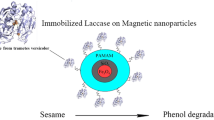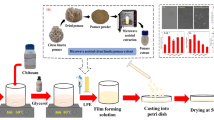Abstract
Laccase from Trametes versicolor was immobilized on TiO2 nanoparticles; the nanocomposites obtained were used for the removal of bisphenol A (BPA) in a liquid food matrix. To achieve a high enzymatic stability over a wide pH range and at temperatures above 50 °C, the nanocomposite structures were prepared by both physical adsorption and covalent linking of the enzyme onto the nanometric support. All the nanocomposite structures retained 40% of their enzymatic activity after 60 days of storage. Proof-of-concept experiments in aqueous media using the nanocomposites resulted on a > 60% BPA removal after 48 h and showed that BPA was depleted within 5 days. The nanocomposites were tested in canned liquid food samples; the removal reached 93.3% within 24 h using the physically adsorbed laccase. For the covalently linked enzyme, maximum BPA removal was 91.3%. The formation of BPA dimers and trimers was observed in all the assays. Food samples with sugar and protein contents above 3 and 4 mg mL−1 showed an inhibitory effect on the enzymatic activity.





Similar content being viewed by others
REFERENCES
Ahmed S, Husain Q (2012) Potential applications of enzymes immobilized on/in nano materials: a review. Biotechnol Adv 30:512–523
Arboleda C, Cabana H, De Pril E, Jones JP, Jiménez GA, Mejía AI, Agathos SN, Penninckx J (2013) Elimination of Bisphenol A and triclosan using enzymatic system of autochthonous colombian forest fungi. Int Sch Res Not 2013:968241
Arroyo M (1998) Inmovilización de enzimas. Fundamentos, métodos y aplicaciones. Ars Pharmaceutica 39:23–39
Ballesteros-Gómez A, Rubio S, Perez-Bendito D (2009) Analytical methods for the determination of bisphenol A in food. J Chromatogr A 1216:449–469
Barbosa O, Torres R, Ortiz C, Fernandez-Lafuente R (2012) Versatility of glutaraldehyde to immobilize lipases: effect of the immobilization protocol on the properties of lipase B from Candida Antarctica. Process Biochem 47:1220–1227
Betancor L, López-Gallego F, Hidalgo A, Alonso-Morales N, Dellamora-Ortiz G, Mateo C, Fernández-Lafuente R, Guisán JM (2006) Different mechanisms of protein immobilization on glutaraldehyde activated supports: effect of support activation and immobilization conditions. Enzyme Microb Technol 39:877–882
Cabana H, Jones JP, Agathos SN (2007a) Elimination of endocrine disrupting chemicals using white rot fungi and their lignin modifying enzymes: a review. Eng Life Sci 7(5):429–456
Cabana H, Habib JL, Rozenberg R, Elisashvili V, Penninckx M, Agathos SN, Jones JP (2007b) Elimination of endocrine disrupting chemicals nonylphenol and bisphenol A and personal care product ingredient triclosan using enzyme preparation from the white rot fungus Coriolopsis polyzoma. Chemosphere 67:770–778
Carvalho CCCR (2011) Enzymatic and whole cell catalysis: finding new strategies for old processes. Biotechnol Adv 29:75–83
Česen M, Lambropoulou D, Laimou-Geraniou M, Koskej T, Blaznik U, Heath D, Heath E (2016) Determination of bisphenols and related compounds in honey and their migration from selected food contact materials. J Agr Food Chem 64:8866–8875
Chai W, Handa Y, Suzuki M, Saito M, Kato N, Horiuchi CA (2005) Biodegradation of bisphenol A by fungi. Appl Biochem Biotechnol 120:175–182
Chen H, Zhang Q, Dang Y, Shu G (2013) The effect of glutaraldehyde cross-linking on the enzyme activity of immobilized β-galactosidase on chitosan bead. Adv J Food Sci Technol 5(7):932–935
Codex Alimentarius Commission – Codex Alimentarius (1993) Pesticide residues in food. FAO/WHO Press, Rome
Cunha S, Fernandes J (2013) Assessment of bisphenol A and bisphenol B in canned vegetables and fruits by gas chromatography-mass spectrometry after QuEChERS and dispersive liquid–liquid microextraction. Food Control 33:549–555
Errico S, Bianco M, Mita L, Migliaccio M, Rossi S, Nicolucci C, Menale C, Portaccio M, Gallo D, Mita DG (2014) Migration of bisphenol A into canned tomatoes produced in Italy: dependence on temperature and storage conditions. Food Chem 160:157–164
Escalona I, de Grooth J, Font J, Nijmeijer K (2014) Removal of BPA by enzyme polymerization using NF membranes. J Membr Sci 468:192–201
Fasano E, Bono-Blay F, Cirilo T, Montouri P, Lacorte S (2012) Migration of phtalates, alkylphenols, bisphenol A and di(2-ethylhexyl)adipate from food packaging. Food Control 27:132–138
Food and Drug Administration (2005), Titanium dioxide. In The United States Code of Federal Regulations, Title 21, Section 73.575, Office of the Federal Register, Washington, D.C
Fukuda T, Uchida H, Suzuki M, Miyamoto H, Morinaga H, Nawata H, Uwajima T (2004) Transformation products of bisphenol A by a recombinant Trametes villosa laccase and their estrogenic activity. J Chem Technol Biotechnol 79:1212–1218
Galliker P, Hommes G, Schlosser D, Corvini PFX, Shahgaldian P (2010) Laccase-modified silica nanoparticles efficiently catalyze the transformation of phenolic compounds. J Colloid Interface Sci 349:98–105
Giulivo M, Lopez de Alda M, Capri E, Barceló D (2016) Human exposure to endocrine disrupting compounds: their role in reproductive systems, metabolic syndrome and breast cancer. A review. Environ Res 151:251–264
Ha DO, Jeong MK, Park CU, Park MH, Chang PS, Lee JH (2009) Effects of riboflavin photosensitization on the degradation of bisphenol A (BPA) in model and real-food systems. J Food Sci 74:380–384
Han MJ, Choi HT, Song HG (2005) Purification and characterization of laccase from the white rot fungus Trametes versicolor. J Microbiol 43:555–560
Hanefeld U, Gardossi L, Magner E (2009) Understanding enzyme immobilization. Chem Soc Rev 38:453–468
Hirano T, Honda Y, Watanabe T, Kuwahara M (2000) Degradation of Bisphenol A by the Lignin-Degrading Enzyme, Manganese peroxidase, produced by White-rot Basidiomycete, Pleurotus ostreatus. Biosci Biotechnol Biochem 64(9):1958–1962
Hou JW, Dong GX, Ye Y, Chen V (2014a) Enzymatic degradation of bisphenol-A with immobilized laccase on TiO2 sol-gel coated PVDF membrane. J Membr Sci 4:212–221
Hou J, Dong G, Luu B, Sengpiel RG, Ye Y, Wessling M, Chen V (2014b) Hybrid membrane with TiO2 based bio-catalytic nanoparticle suspension system for the degradation of bisphenol-A. Bioresour Technol 169:475–483
Hou JW, Dong GX, Ye Y, Chen V (2014c) Laccase immobilization on titania nanoparticles and titania-functionalized membranes. J Membr Sci 452:229–240
Jolivalt C, Madzak C, Brault A, Caminade E, Malosse C, Mougin C (2005) Expression of laccase IIIb from the white-rot fungus Trametes versicolor in the yeast Yarrowia lipolytica for environmental applications. Appl Microbiol Biotechnol 66(4):450–456
Liang R, Hu AM, Li WJ, Zhou YN (2013) Enhanced degradation of persistent pharmaceuticals found in wastewater treatment effluents using TiO2 nanobelt photocatalysts. J Nanopart Res 15:1–13
Linley S, Liu YY, Ptacek CJ, Blowes DW, Gu FX (2014) Recyclable graphene ocide-supported titanium dioxide photocatalysts with tunable properties. ACS Appl Mater Interfaces 6(7):4658–4668
Mansilha C, Silva P, Rocha S, Gameiro P, Domingues V, Pinho C, Ferreira I (2013) Bisphenol A migration from plastic materials: direct insight of ecotoxicity in Daphnia magna. Environ Sci Pollut R 20:6007–6018
Mateo C, Palomo JM, Fernandez-Lorente G, Guisan JM, Fernandez-Lafuente R (2007) Improvement of enzyme activity, stability and selectivity via immobilization techniques. Enzyme Microb Technol 40:1451–1463
Migneault I, Dartiguenave C, Bertrand MJ, Waldron KC (2004) Glutaraldehyde: behavior in aqueous solution, reaction with proteins, and application to enzyme crosslinking. Biotechniques 37:790–806
Miller G (1959) Use of dinitrosalicylic acid reagent for determination of reducing sugar. Anal Chem 31:426–428
Sacco O, Vaiano V, Han C, Sannino D, Dionysiou DD, Ciambelli P (2015) Long afterglow Green phosphorous functionalized with Fe—N doped TiO2 for the photocatalytic removal of emerging contaminants, ICHEAP12: 12th International Conference on Chemical & Process Engineering, Milano, Italy, May 19–22, 2015
Pierucci S, Klemes JJ (2015) The Role of Pressure in the Heat of Pyrolysis of a Lignocellulosic Biomass. In Chemical Engineering Transactions, Italian Association of Chemical Engineering-AIDIC pp. 451–456
Sungur Ş, Köroğlu M, Özkan A (2014) Determination of bisphenol a migrating from canned food and beverages in markets. Food Chem 142:87–91
Suyana P, Ganguly P, Nair BN, Mohamed AP, Warrier KGK, Hareesh US (2017) Co3O4–C3N4 p-n nano-heterojunctions for the simultaneous degradation of a mixture of pollutants under solar irradiation. Environ Sci Nano 4:212–221
Walt DR, Agayn VI (1994) The chemistry of enzyme and protein immobilization with glutaraldehyde. Trends Analyt Chem 13:425–430
Waterborg JH (2002) The Lowry method for protein quantification. In: Walker JM (ed) The protein protocols handbook. Humana Press Inc, New Jersey, pp 7–9
Zhang W, Yin K, Chen L (2013) Bacteria-mediated bisphenol A degradation. Appl Microbiol Biotechnol 97:5681–5689
Acknowledgements
This work was supported by Fondo Semilla (FQ-UNAM) and PAPIIT (DGAPA-UNAM) Project IA205019. We also would like to thank Consejo Nacional de Ciencia y Tecnología (CONACyT) for postdoctoral fellowship (NTO) [291113].
Author information
Authors and Affiliations
Corresponding author
Additional information
Publisher’s Note
Springer Nature remains neutral with regard to jurisdictional claims in published maps and institutional affiliations.
Rights and permissions
About this article
Cite this article
Tapia-Orozco, N., Meléndez-Saavedra, F., Figueroa, M. et al. Removal of bisphenol A in canned liquid food by enzyme-based nanocomposites. Appl Nanosci 8, 427–434 (2018). https://doi.org/10.1007/s13204-018-0675-2
Received:
Accepted:
Published:
Issue Date:
DOI: https://doi.org/10.1007/s13204-018-0675-2




